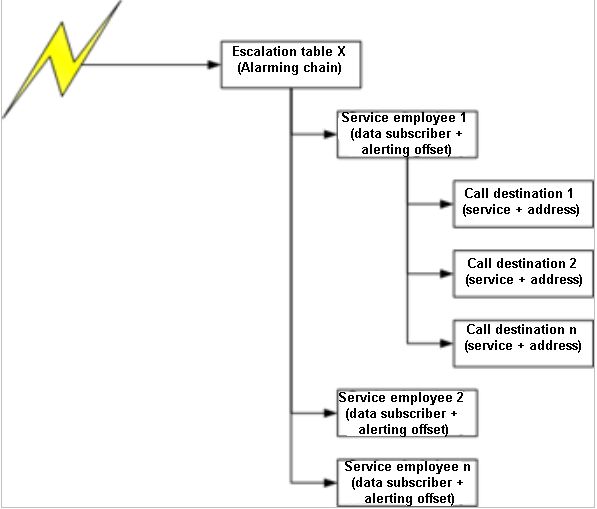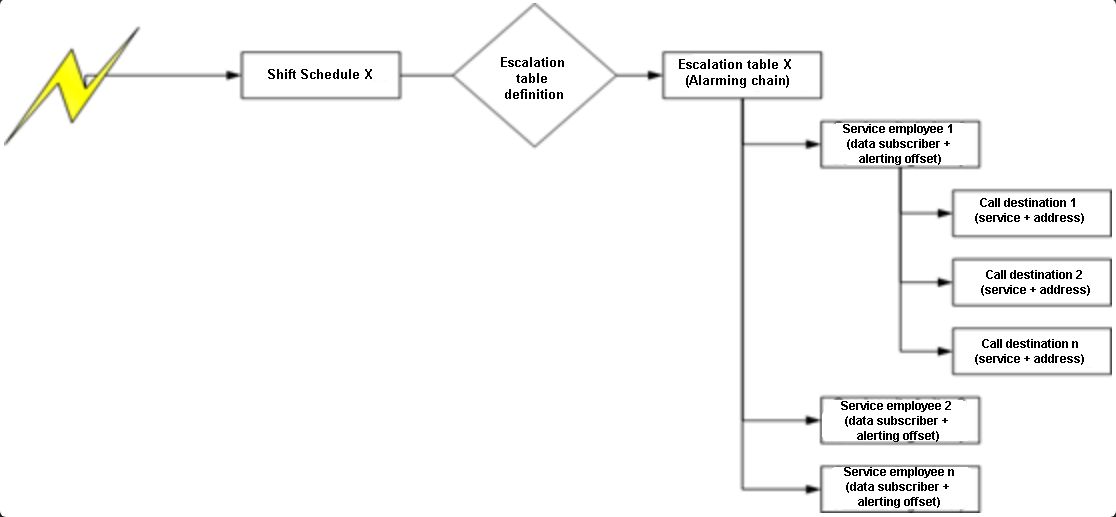MessengerPro Functions and definitions
This article describes the WEBfactory i4scada MessengerPro functions and the supported communication services.
Supported communication services
The following communications services are supported when alerting the service employees:
Email, Pager
Short Message Service (SMS)
Fax
Voice Message
Usually, the message is composed of:
Alarm qualifier
Alarm text
Extension text
Time of alarm occurrence
This information is separated by a period.
When notifications are sent via email, additional service documents can be attached to the email notification.
An email or fax notification includes:
Header – this optional text is the same in all notifications.
Message
Footer – this optional text is the same in all notifications.
SMS notifications are sent via analogue modems, GMS modems or ISDN devices. Since the SMS text is limited to 160 characters (based on the providers settings), the notification might be truncated.
For Voice messages, the computer reads the notification text. i4SACAD MessengerPro uses the Microsoft SAPI5 interface (voice engine). This open interface can be used in different available languages.
The voice interface SAPI5 and the English language are included in Windows XP or later.
The SAPI interface version 5.1 is available for free here.
The above package includes two English language engines.
Please note that due to licensing reasons, no voice engine can be shipped with i4scada MessengerPro. Any voice engine based on SAPI5 can be used.
The 4-bit ADPCM method is used for speech generation. The modem or ISDN card must support this procedure.
i4scada tested devices:
Modem: Devolo MicroLink 56k i (“i” stands for Industry Standard)
GSM Modem: Siemens MC35i, Westermo GDW-11
ISDN card: Fritz!Card USB V2.1
USB device server: Silex Technologies SX3000GB for indirect coupling of Fritz!Card USB V2.1
SMS gateway
MC Technologies MC89 LTE Terminal
A voice message is composed of three parts:
Welcome sequence: starts when the call is answered. The Welcome sequence is the same for all notifications.
Message sequence: consists of the unique alarm ID, the alarm text and additional texts. The alarm text is set up in i4scada Studio.
Final sequence: similar to the Welcome sequence, it is the same for all notifications.
The voice message must be played to the final sequence. Otherwise, the call will be marked as failed and will be repeated. Quitting the call during the message delivery is possible.
Remote Acknowledgement
Each service employee can acknowledge certain alarms if he is entitled to. Using a wired phone or a mobile phone or email, the alarm can be acknowledged by entering the alarm identifier and the employee number. If the acknowledgement is complete, no further notifications will be sent.
The remote acknowledgement is passed to the i4scada alarming system. This makes possible both the remote acknowledgement and the acknowledgement of the alarm from the visualisation. The remote alarm acknowledgement via DTMF (Dual Tone Multi Frequency) is possible as the alarm occurs or at a later date.
Alarm Mode
The alarm mode is regulated by the temporal and organizational procedures for alerting service personnel. The rules are assigned to the alarm occurrence during configuration. In the following subsections, the three different alarm modes supported by i4scada MessengerPro will be described.
In all alarm modes, the escalation table is followed. The escalation table sets out clear which service employee is notified, the time of notification and what notification service is used. Each service employee can specify multiple notification services, called “call destinations”. The alarm notification will be sent to each specified call destination.
If a Fax or Voice call cannot reach the destination due to a busy line, the Voice call/Fax will be repeated at a later date. The time interval after an unsuccessful notification attempt is defined during configuration for each communication service.
The alarm chain determined by the escalation table is interrupted only when the alarm has been acknowledged through the visualisation or when enough positive alarm acknowledgements have been received.
Direct Notification
When is operated without the MessengerPro module, sending alarm notifications is still possible. These notifications are directly assigned to a person and don’t follow the escalation tables, schedules or alarm groups.
The parametrisation of the notification levels is independent of the used version and always possible.

Direct Notification example
Alarm Escalation Tables
Immediately after the notification request has been received, the i4scada MessengerPro determines, based on the assigned escalation table, the service employee to receive the notification and the call destinations.

Alarm Escalation Table example
Alerting according to Shift Schedules
When an alarm notification is to be sent to a service employee according to a shift schedule, i4scada MessengerPro first finds the shift schedule at the time of occurrence, using the occurrence time and the shift schedule. Based on this data, it uses the appropriate escalation table inside the shift schedule and afterwards the service employees.

Alerting according to Shift Schedules
Alerting according to Alarm Groups
i4scada MessengerPro determines to which service unit to send the alarm notifications based on the alarm group that contains the triggered alarm. Each service unit has an associated shift schedule. The employees will be notified based on the associated shift plan and the escalation table.

Alerting according to Alarm Groups
The alarm notifications using alarm groups allow the usage of multiple shift schedules simultaneously. If two shift schedules are associated with one alarm group, both associated service units will be notified according to the shift schedule and the escalation table. Ex: The electricians and the mechanics.
Notification Log
Every action is logged in i4scada MessengerPro, including event notifications. Here are the following messages:
Successful transmission
Line busy
Member not reachable
Communication error
User abort
Remote acknowledgement
Remote acknowledgement , escalation interrupted
Alarm goes, escalation interrupted
Alarm is acknowledged, escalation interrupted
The exact time each employee was notified is logged. Additionally, any change of the alarm status will be logged in MessengerPro call log.